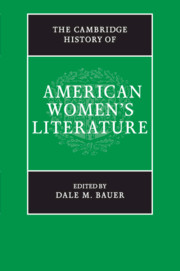Book contents
- Frontmatter
- Contents
- List of illustrations
- Acknowledgements
- Notes on contributors
- Introduction
- 1 The stories we tell: American Indian women's writing and the persistence of tradition
- 2 Women writers and war
- 3 American women's writing in the colonial period
- 4 Religion, sensibility, and sympathy
- 5 Women's writing of the Revolutionary era
- 6 Women writers and the early US novel
- 7 Women in literary culture during the long nineteenth century
- 8 Moral authority as literary property in mid-nineteenth-century print culture
- 9 The shape of Catharine Sedgwick's career
- 10 Writing, authorship, and genius: literary women and modes of literary production
- 11 Nineteenth-century American women's poetry: past and prospects
- 12 Transatlantic sympathies and nineteenth-century women's writing
- 13 Nineteenth-century African American women writers
- 14 Local knowledge and women's regional writing
- 15 Women and children first: female writers of American children's literature
- 16 US suffrage literature
- 17 American women playwrights
- 18 Turn-of-the-twentieth-century transitions: women on the edge of tomorrow
- 19 Accidents, agency, and American literary naturalism
- 20 The geography of ladyhood: racializing the novel of manners
- 21 Self-made women: novelists of the 1920s
- 22 Recovering the legacy of Zara Wright and the twentieth-century black woman writer
- 23 Jewish American women writers
- 24 Women on the breadlines
- 25 Modern domestic realism in America, 1950–1970
- 26 Lyric, gender, and subjectivity in modern and contemporary women's poetry
- 27 Contemporary American women's writing: women and violence
- 28 Asian American women's literature and the promise of committed art
- 29 Straight sex, queer text: American women novelists
- 30 Latina writers and the usable past
- 31 Where is she? Women/access/rhetoric
- 32 Reading women in America
- Index
- References
8 - Moral authority as literary property in mid-nineteenth-century print culture
Published online by Cambridge University Press: 28 September 2012
- Frontmatter
- Contents
- List of illustrations
- Acknowledgements
- Notes on contributors
- Introduction
- 1 The stories we tell: American Indian women's writing and the persistence of tradition
- 2 Women writers and war
- 3 American women's writing in the colonial period
- 4 Religion, sensibility, and sympathy
- 5 Women's writing of the Revolutionary era
- 6 Women writers and the early US novel
- 7 Women in literary culture during the long nineteenth century
- 8 Moral authority as literary property in mid-nineteenth-century print culture
- 9 The shape of Catharine Sedgwick's career
- 10 Writing, authorship, and genius: literary women and modes of literary production
- 11 Nineteenth-century American women's poetry: past and prospects
- 12 Transatlantic sympathies and nineteenth-century women's writing
- 13 Nineteenth-century African American women writers
- 14 Local knowledge and women's regional writing
- 15 Women and children first: female writers of American children's literature
- 16 US suffrage literature
- 17 American women playwrights
- 18 Turn-of-the-twentieth-century transitions: women on the edge of tomorrow
- 19 Accidents, agency, and American literary naturalism
- 20 The geography of ladyhood: racializing the novel of manners
- 21 Self-made women: novelists of the 1920s
- 22 Recovering the legacy of Zara Wright and the twentieth-century black woman writer
- 23 Jewish American women writers
- 24 Women on the breadlines
- 25 Modern domestic realism in America, 1950–1970
- 26 Lyric, gender, and subjectivity in modern and contemporary women's poetry
- 27 Contemporary American women's writing: women and violence
- 28 Asian American women's literature and the promise of committed art
- 29 Straight sex, queer text: American women novelists
- 30 Latina writers and the usable past
- 31 Where is she? Women/access/rhetoric
- 32 Reading women in America
- Index
- References
Summary
The Liberator, which covered Harriet Beecher Stowe's 1853 tour of England in minute detail, described in its June 10 issue a London antislavery event at which Stowe had appeared as guest of honor: “The assembly filed past Mrs. Stowe, exchanging courtesies, and afterwards adjourned to supper, where a marble bust of Mrs. Stowe, by Bernard, was exhibited” (“Mrs. Stowe,” 91). The sheer oddity of these attendees encountering Stowe and her marble likeness in rapid succession intensifies the contrast between the cool, white stillness of the bust – suggestive of remoteness, authority, purity, status – and the live, conversant, dare I say mildly frumpy author before them. The juxtaposition collapses time, preempting the long process of canonization that would ordinarily precede the commissioning of an author's bust, a static object calculated to signify his or her timelessness. Their coexistence also undermines the customary distance between presence and reputation, the bust reminding guests of Stowe's preeminence in the world of letters and of social reform, even as she eats her dinner among them.
This marble rendering – signifying a moment at which Stowe becomes literally iconic – both indexes and asserts the synergy among her popularity, her literary status, and her moral authority, insofar as the author's celebrity in England was, in the early to mid-1850s, inextricable from her antislavery advocacy via fiction. But the terms of those linkages, within and beyond English abolitionist circles and the Liberator's readership, are not entirely clear.
- Type
- Chapter
- Information
- The Cambridge History of American Women's Literature , pp. 165 - 184Publisher: Cambridge University PressPrint publication year: 2012
References
- 1
- Cited by



